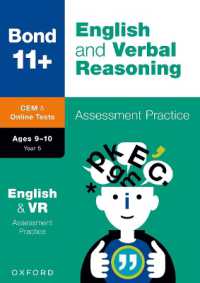Full Description
Hearing voices, seeing visions and similar out-of-the-ordinary experiences have long intrigued and mystified humankind. The dominant scientific and medical understandings of these phenomena tend to problematise them. This ground-breaking book builds on the work of the Hearing Voices Movement and of the researchers Marius Romme and Sandra Escher in challenging this perception. The book is a collection of chapters by voice hearers, mental health professionals and researchers describing a myriad of therapeutic and creative approaches and strategies that people find helpful in relating to voices when they find them distressing. It is based on insights, understandings and knowledge derived from the first-hand experience of voice hearers and from mental health practice and research that show that the person's relationship with the voices and what the voices say are key to understanding and living with them; that voices are not in themselves a problem and can even be helpful; that there is a strong connection between voices and unwanted emotions; that life-long medication is not the inevitable and only treatment and, most importantly perhaps, that voice hearers can live well with their voices (even if it is sometimes hard work). The book is presented in three parts: Part one, 'Hearing our voices', includes voice hearers' perspectives as to what has helped them to recover from breakdown so that they are able to live full lives, including Hearing Voices Groups and peer support. Part two, 'Emerging social and therapeutic approaches to working with voices', explores different mainstream non-medical and psychotherapeutic approaches that help voice hearers to make sense of and live well with their voices. Part three, 'Creative approaches to working with voices', describes using creative arts, such as dance, drama and poetry, to help voice hearers relate to their voices in positive ways.
Contents
Foreword - Marius Romme and Sandra Escher; Introduction - Isla Parker, Joachim Schnackenberg and Mark Hopfenbeck; Part one: Hearing our voices; 1. The Maastricht Approach: social and personal perspectives on hearing voices - Dirk Corstens; 2. Hearing voices: why the words we use matter - Akiko Hart; 3. Hearing voices groups - Peter Bullimore; 4. Facilitating hearing voices groups - Sasha Priddy and Charlotte Howard; 5. Painting has helped me to cope with my voices - Reshma Valliappan; 6. Voices: victim to victor - Ron Coleman; 7. The things they say - Aimee Wilson; 8. Journey to recovery - Clifford O'Connor; 9. Hearing voices in grief - Jacqueline Hayes; 10. Spirituality, religion and voices - Christopher C.H. Cook; 11. Voice hearing and cannabis: a harm-reduction approach - Rufus May and Kate Quinn; 12. Black voices and the deafness of whiteness - Colin King; Part two - Emerging social and therapeutic approaches to working with voices; 13. Voices, values and values-based practice: engaging with what matters in voice hearing - David Crepaz-Keay and Bill (K.W.M.) Fulford; 14. An invitation to dialogue: what we can all learn from Open Dialogue and Hearing Voices Networks - Olga Runciman and Iseult Twamley; 15. Medication and voices: reflections from a relational perspective - Dirk Corstens and Joachim Schnackenberg; 16. Voice hearers at work - Caroline Moughton; 17. Navigating university as a voice hearer - Deborah Altman; 18. Experience focused counselling (Making sense of voices) - Joachim K. Schnackenberg, Oana-Mihaela Iusco and Senait Debesay; 19. Voice Dialogue - Ruth Lafferty and Rob Allison; 20. Experience focused counselling with children and young people who hear voices - Senait Debesay; 21. Understanding voices while living with dementia - David Storm and Ron Coleman; 22. How cognitive behaviour therapy can help people who are distressed by hearing voices - Mark Hayward; 23. Recovery-oriented cognitive therapy and distressing voices - Aaron Brinen; 24. AVATAR therapy: a digital therapy to help people with distressing voices - Mar Rus-Calafell and Tom Craig; 25. Relating therapy for voices: learning how to respond assertively in difficult relationships - Mark Hayward, Sheila Evenden and Angie Culham; 26. Meaning-making in voice hearing - Nicola Barclay, Guy Dodgson, and Anna Luce; 27. Responding to trauma dialogically: an introduction to peer-supported Open Dialogue - Mark Hopfenbeck; 29. A psychodynamic understanding of voice hearing - Christine Cox; 29. Compassion-focused therapy and the courage of compassionate relating to voices - Charles Heriot-Maitland; 30. Working with voices using the narrative genogram - Lykourgos Karatzaferis; 31. Mindfulness and hearing voices - Rufus May and Elisabeth Svanholmer; Part three - Creative approaches to working with voices; 32. Creative ways to engage with voices - Rufus May and Elisabeth Svanholmer; 33. Dramatherapy for people who hear voices - Louise Combes; 34. Dance movement psychotherapy and voice hearing: looking outward and inward - Mary Coaten; 35. Awesome metalcore therapy: using heavy metal music in therapeutic work with voices - Kate Quinn and Daniel Baines; 36. A safe space: sound therapy and hearing voices - Jane Ford; 37. How writing memoirs and poetry may help voice hearers - Isla Parker; 38. Music therapy in multi-disciplinary treatment - Stella Compton Dickinson; Conclusion - Isla Parker, Joachim Schnackenberg and Mark Hopfenbeck; Afterword - Gail A. Hornstein








